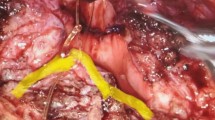Abstract
Objectives
To evaluate the efficacy and safety of 2 micron continuous wave laser resection of non-muscle-invasive bladder tumor (NMIBT) compared with holmium laser resection of bladder tumor (HoLRBT) and standard transurethral resection of bladder tumor (TURBT).
Methods
Since April 2006 to August 2007, 97 patients with NMIBT were retrospectively collected in this study. All of them were classified into 3 groups, which were treated with 2 micron continuous wave laser resection, holmium laser resection and TURBT, respectively. The preoperative, intraoperative and postoperative clinical data were recorded and compared using SAS 6.12 statistical software.
Results
There were no differences with the preoperative characteristics among the three groups, except the diameter of the tumors. The maximum diameter of the tumors in 2 micron laser group was larger than the other two groups (P < 0.05). Two micron laser group was associated with less hemoglobin decrease compared with TURBT group (P < 0.05). All of the patients were followed and the recurrence rate of the three groups indicated no statistical significance (P > 0.05).
Conclusions
In conclusion, 2 micron continuous wave laser resection of non-muscle-invasive bladder tumor is a safe and reliable treatment. With the distinguished hemostasis, it is an available optional treatment.
Similar content being viewed by others
References
Madeb R, Messing EM (2004) Gender, racial and age differences in bladder cancer incidence and mortality. Urol Oncol 22(2):86–92
Underwood W 3rd, Dunn RL, Williams C et al (2006) Gender and geographic influence on the racial disparity in bladder cancer mortality in the US. J Am Coll Surg 202(2):284–290
No authors listed (2009) StatBite: A look at bladder cancer in the United States. J Natl Cancer Inst 101(22):1533
Shi B, Zhang K, Zhang J et al (2008) Relationship between patient age and superficial transitional cell carcinoma characteristics. Urology 71(6):1186–1190
Pietrow PK, Smith JJ (2001) Laser treatment for invasive and noninvasive carcinoma of the bladder. J Endourol 15(4):415–418
Devos D, Creac’h C, Laureau E et al (2000) Thulium laser evoked potentials. Normative values for the arms and legs. Neurophysiol Clin 30(5):313–322
Fried NM, Murray KE (2005) High-Power thulium fiber laser ablation of urinary tissues at 1.94um. J Endourol 19(1):25–31
Xia SJ, Zhuo J, Sun XW et al (2008) Thulium laser versus standard transurethral resection of the prostate: a randomized prospective trial. Eur Urol 53(2):382–389
Xia SJ, Zhang YN, Lu J et al (2005) Thulium laser resection of prostate-tangerine technique in treatment of benign prostate hyperplasia. Zhonghua Yi Xue Za Zhi 85(45):3225–3228
Gao X, Ren S, Xu C et al (2008) Thulium laser resection via a flexible cystoscope for recurrent non-muscle-invasive bladder cancer: initial clinical experience. BJU Int 102(9):1115–1118
Yang Y, Hong BF, Wei ZT (2008) Continuous wave laser of 2 microm for bladder tumor treatment. Zhonghua Wai Ke Za Zhi 46(18):1410–1412
Okamura K, Ono Y, Kinukawa T et al (2002) Randomized study of single early instillation of (2”R)-4’-O-tetrahydropyranyl-doxorubicin for a single superficial bladder carcinoma. Cancer 94(9):2363–2368
Böhle A, Leyh H, Frei C et al (2009) Single postoperative instillation of gemcitabine in patients with non-muscle-invasive transitional cell carcinoma of the bladder: a randomised, double-blind, placebo-controlled phase III multicentre study. Eur Urol 56(3):495–503
Syed HA, Biyani CS, Bryan N et al (2001) Holmium:YAG laser treatment of recurrent superficial bladder carcinoma: initial clinical experience. J Endourol 15(6):625–627
Xishuang S, Deyong Y, Xiangyu C et al (2010) Comparing the safety and efficiency of conventional monopolar, plasmakinetic, and holmium laser transurethral resection of primary non-muscle invasive bladder cancer. J Endourol 24(1):69–73
Zhu Y, Jiang X, Zhang J et al (2008) Safety and efficacy of holmium laser resection for primary nonmuscle-invasive bladder cancer versus transurethral electroresection: single-center experience. Urology 72(3):608–612
Saito S (2001) Transurethral en bloc resection of bladder tumors. J Urol 166(6):2148–2150
Marks AJ, Teichman JM (2007) Lasers in clinical urology: state of the art and new horizons. World J Urol 25(3):227–233
Smith JA (1989) Current concepts in laser treatment of bladder cancer [J]. Prog Clin Biol Res 303:463–469
Conflict of interest statement
There is no conflict of interest.
Author information
Authors and Affiliations
Corresponding author
Rights and permissions
About this article
Cite this article
Zhong, C., Guo, S., Tang, Y. et al. Clinical observation on 2 micron laser for non-muscle-invasive bladder tumor treatment: single-center experience. World J Urol 28, 157–161 (2010). https://doi.org/10.1007/s00345-010-0532-8
Received:
Accepted:
Published:
Issue Date:
DOI: https://doi.org/10.1007/s00345-010-0532-8




